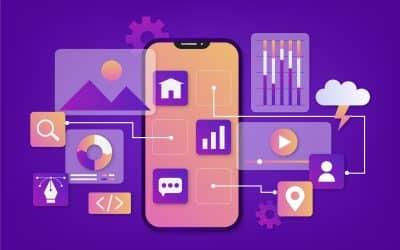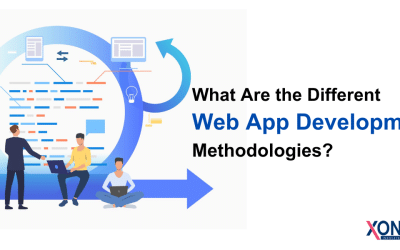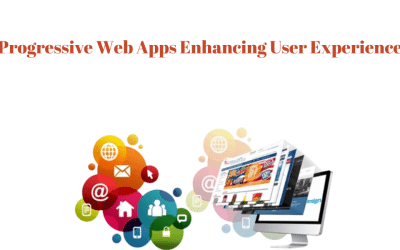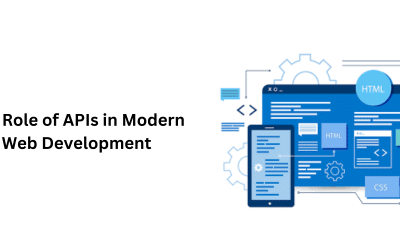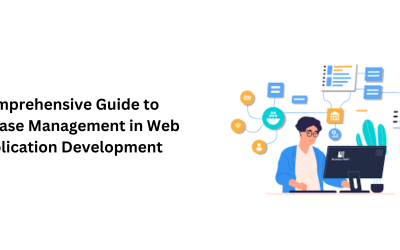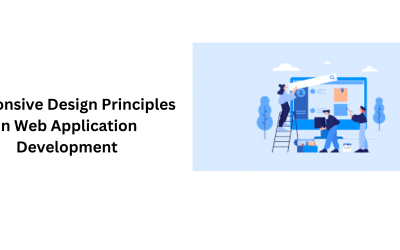Success in any field requires staying current on the latest trends and issues and devising new methods to improve your business or company unit’s products. One of the most effective ways to achieve this is through applying the latest web application development techniques. Understanding the modern web app development environment is difficult without knowing the basic principles. They will assist you in creating your apps correctly and ensure they’re compatible with the technology or programming language you’re using!
Web-based applications are server-client computer applications that users use to access the internet in a browser. They are client-side applications with a user interface. The most well-known web-based apps are instant messaging, web sales, online sales, and webmail.
So, now the question is: how do Web Development Company USA develop high-quality web applications? The solution is easy. The only thing they need to do is comply with modern app and web design rules.
The creation of a successful website is complex. Modern web applications require flexibility, security, and scalability to accommodate customers’ future demands. In this regard, we’ve developed some essential guidelines for any aspiring business owner before establishing the company’s internet website.
Let’s look around.
What Is Web Application Development?
Web applications allow users to connect and collaborate through their browsers on the internet. Internet access is the primary differentiator between a website and conventional desktop applications. Web-based applications use a client-server design, in which the user (user’s browser) connects to a server running the app.
Web-based applications differ in terms of complexity and function. They may be essential and purely for one purpose, such as calculators or a task list. However, they could also be complex and multifaceted, including collaborative tools online and an eCommerce platform. Examples of this include Google Docs, Gmail, Trello, and online banking platforms.
It’s crucial to know the basics of web application development before exploring modern techniques. In the contemporary age, web application development involves creating responsive, dynamic websites that utilize the most advanced methods and tools to provide users with a seamless, enjoyable, and valuable online experience.
Web pages that were static dominated the web at the beginning of the web. However, users’ demands for more advanced and interactive online apps have increased. Today, the ability to react, interact, and adapt to different sizes and types of devices makes the latest web applications unique.
Benefits Of Web Applications For Businesses
The benefits of the development of web applications for businesses:
Unparalleled Accessibility
Web-based applications are accessible on any device with internet connectivity, including tablets, laptops, desktops, and even smartphones. This flexibility allows companies to expand to a larger user base and accommodates the ever-growing number of mobile device users.
Real-time Data Processing and Synchronization
Changes made by one person immediately reflect on all devices and sessions. This ensures that data is consistent and collaborative, which is especially beneficial when sharing documents in software such as project management and collaborative document editing tools.
Personalization and Customization Opportunities
Web-based applications let businesses track user preferences and data. These data are utilized to provide specific content and advice for user experience, improving user engagement, conversion, and customer loyalty.
Enhanced Interactivity
Modern web-based applications offer an extremely high degree of interactivity, providing a smooth and exciting user experience. Features like drag-and-drop, real-time updates, and interactive interfaces create an interactive user interface.
Modern Business Strategies
Web applications have emerged as an integral part of modern business plans. They aid in revenue growth, differentiation, and better customer experiences, making them crucial company investments.
What Are The Types Of Web Applications?
Web-based applications are classified by their function operations, mechanisms of operation, or the technology they use to create them. These are the most common types of web-based apps:
Static Web Applications
Static web applications are sites that show fixed content to visitors. They are composed of HTML, CSS, and JavaScript files, which are delivered by default to the user’s web browser. Static web applications are usually utilized for basic informational websites or landing pages that do not require much interaction from the user.
Dynamic Web Applications
Dynamic web applications create content in real-time based on users’ demands and input. They pull data from APIs, databases, and other sources and then present it to users in real-time. These applications typically have user authentication, customized content, and interactive capabilities. Techniques like server-side scripting languages (e.g., PHP, Ruby, Python) or serverless architectures are often utilized by Custom Web Application Development Company to develop dynamic web apps.
E-commerce Applications
E-commerce platforms allow online shopping and selling of goods or services. They include features like catalogs of products and shopping carts, secured payment gateways, and the ability to manage orders. Online shopping apps range from basic online shops to massive platforms that handle inventory management, customers’ accounts, inventory management, and complex transaction workflows.
Social Media Applications
Social media apps connect users and allow communication, content sharing, and networking. They feature the user’s profile, friends’ connections, messages, news feeds, and multimedia sharing. Popular social media platforms include Facebook, Twitter, Instagram and Linkedin.
Real-Time Web Applications
Real-time web applications instantly provide information and changes to users without needing to refresh the page. They use technologies like WebSockets or server-sent events to create persistent connections between the client and server. Real-time web apps can be utilized for chat programs as well as collaborative tools, live streaming, and monitoring systems that are real-time.
Progressive Web Applications (PWAs)
Progressive Web Applications combine the most popular web features with native apps. They utilize the latest web technologies for a similar experience as apps that include offline capabilities such as push notifications and access to the device. PWAs can be used with web browsers and installed on users’ devices, eliminating the requirement to submit separate application store applications.
Single Page Applications (SPA)
Single-Page Application (SPA) is an internet application running on one HTML page. In contrast to traditional web apps that need multiple page refreshes while moving between pages or sections, SPAs dynamically update the page and do not refresh the page. It results in a smoother and more user-friendly experience. Most SPAs are built with JavaScript frameworks like AngularJS, React, or Vue.js.
Business Web Applications
Business web-based applications assist small and medium-sized enterprises with standard requirements such as inventory management, CRM, employee management, billing, and reports. They can provide central data storage, collaboration capabilities, and the ability to customize operations to increase productivity and enhance decision-making quality.
Principles Of Web Application Development
The path to modern web development begins with knowledge of current web development concepts. While it’s not a complete guide, the following are essential elements of contemporary web application development that every Web Application Development Company should know.
User-First
It’s simple. You must consider the user’s acceptance as you would every other item or service. The web was developed in the beginning, but earlier, it was devices, later technologies, and then new technologies. However, one principle that has remained the same is the user experience.
Inspiring your customers with the newest technology or adding many elements together to decrease the time it takes to complete a task is not a reason not to provide an excellent user experience. Any application that you develop must be accessible to users. When considering the user experience, a common concern that’s often overlooked is who the user is. Answering this question will help clarify your purpose for creating this particular web application.
Instead of looking at the application as a tool rather than a web application, you’ll start designing it as an answer to a specific issue. Once you know the goal, you can begin working on the best user experience. In the end, it’s the customer experience that keeps a user loyal to a company or product.
Use an API-first approach
The API-first method views APIs as distinct and modular components of a web application. The application’s functions are fully accessible using an API. This method also makes it easier to manage scaling, as applications built using smaller, disaggregated parts can be scaled effectively by scaling only the required elements. API gateways are then utilized to offer a broad range of capabilities across various API ends.
The API gateway acts as the sole entry point for the application. It takes multiple requests made by the user and routes these to appropriate ends. It then blends the results of the various requests and sends them to the user, making reducing the number of interactions between users and the application on the web easier.
Explicitly Declare And Isolate Dependencies For The Software
The best practice is to begin by making an outline of all the other external libraries and applications you have used. These should be distinct from the code and can be quickly turned off or switched back on when needed. This lets you do more without affecting the code overall.
To control libraries, for example, use a Composer. This is a fantastic option for creating and managing libraries required by your website application. The composer will create a file named composer lock. There, you’ll find the identical (exact) edition of every application that you download. This is the same package used during the composer’s installation.
Store composer. Lock within your Git repository and remove vendor folders from Git. This method will ensure that all deployments (for other developers, production servers, or staging) have identical versions of the library after you execute the “composer install” command. Follow this to avoid having different app versions in production, which could create unstable app behavior.
Security Is Not An Add-On Feature
Many web-based applications are vulnerable to high-severity security vulnerabilities like Cross-Site Scripting, SQL Injection, and others. In short, the majority of web-based applications for business are afflicted by the most well-known yet easily fixed security weaknesses. These aren’t recent dangers. They have actually been identified as the major security risk for ten years in a row.
What is the reason this happens? The reasons for this may differ, but the most critical issue is that many developers take an uncritical approach to security. They view it as an element that they could add later. This approach differs from how modern web application security works. Now more than ever, you should incorporate security into the web application from the beginning.
Tools Are The Best Friend You Can Have
Before, app and web development was a more specific area of focus. The majority of developers focus on one language to use for app development. However, this has changed with time progression, as a modern web developer is nothing short of a “jack-of-all-trades.”
They should know the latest architectures, UX principles, JavaScript and responsive web design API integration, web vulnerabilities, more than one web development tool, and several programming languages. Therefore, they require an always-changing set of skills that complicate it. Furthermore, web developers today are under more stress than ever before. The business world expects their apps to be up and running quickly and without compromise on security or functionality. The question now is how modern web developers can tackle these challenges.
To accomplish this, they require the latest tools and techniques for web app development. These web-based tools help develop web applications faster and provide the necessary skills. Developers can accomplish tasks they could not accomplish on their own.
Applications Thrive on Speed
The requirement for speedy web-based applications has dramatically increased in the past couple of years. Why? In the beginning, people became less attentive. The average person has shorter attention spans than goldfish, which are more common. So, future web-based applications will be able to process more significant volumes of data than ever.
If they are correctly optimized, the data growth could result in faster apps, which can ultimately result in a loss of users. Secondly, Page speed can be beneficial to businesses. Google has pushed this direction by revealing that they view page loading speed as a ranking aspect. This is why optimizing the performance of web applications has rapidly become a vital component of development.
Change Is A Never-Ending Process
Technology is constantly developing. For developers, this is a good thing and a drawback. On one hand, the development of web applications is constantly improving, with new libraries and tools for web-based application development and frameworks being released regularly. The new developments result in improved application capabilities and more efficient Web App Development Services.
In contrast, there are security flaws that are constantly increasing. Web applications that were previously secure could now be a visible security flaw. Developers must keep the application current according to the most recent security requirements. Also, contemporary web-based apps need to be completed. You can’t install an application only to abandon it. Today, web developers must frequently update their websites to adapt to evolving trends and security requirements.
Separation of Modules
In the past, developers employed a unidirectional web application development method, incorporating each feature directly within their applications. One of the main issues with this model is maintenance. Any module could use problems in different sections, making software uncontrollable.
Today, modern application development frameworks require a separation of interests. The n-tier technique is widely used to develop apps and websites, splitting applications into distinct layers. One benefit of this development method is managing and creating each module and layer independently.
Be Picky With The Platforms
What kind of mobile app are you planning to develop? Mobile or web-based? What technology do you prefer to use, and on which platforms? Native or Hybrid? iOS Or Android? Are you using Android or iOS? You must answer these questions and plan out your options before committing to your creation and development phase. As a general rule of thumb, keep to the devices and platforms that are the most well-known to the market you want to target. Utilize analytics to gather the necessary information and prioritize according to the data.
In general, you will find three primary kinds of apps that include hybrid, native as well as web-based application development.
# Native App Development
Native app development involves crafting applications specifically tailored for certain platforms, such as iOS or Android, using tools such as Flutter and React. Although native app development is generally costlier and more time-consuming than other development methods, it offers the most satisfying and customized user experience, as the apps are specially designed to work on the platform and device of choice.
# Hybrid App Development
Hybrid application development uses a combination of web and native technologies to develop apps that can be used on various platforms. It can serve as an ideal means of connecting web development to native app design. It allows developers to run on various platforms and provide a superior user experience. Hybrid app development is the master of both trades but not the expert.
# Web App Development
Web app development concentrates on developing apps that can be accessed through a browser on the web using platforms like Next.JS and Strapi. It is the easiest and least expensive method of building an application. However, it is essential to consider the possibility that your intended audience will connect to it using a browser such as a Web browser. When mobile traffic is the primary component of your website’s traffic, mobile applications have more value than web-based apps.
Every design method has advantages and drawbacks. Therefore, you must pick the one that best suits your needs, particularly your business services and your customers’ preferences.
Understand the Importance of Architecture
The emphasis on developing nowadays is centered around users’ experience. As an engineer, you’re expected to offer users user-friendly and efficient applications, but in the absence of this, your application is at risk—the likelihood of not being noticed.
Stay focused on the interface so that you pay attention to the most crucial aspect of your application’s architecture. Although an application’s architecture may appear invisible to the user, its impact on your overall app can be huge.
The snippet that includes the anchor URL and the target URL Architecture, for instance, affects the scalability, flexibility, maintenance, and security. So, a well-designed architecture requires more time to develop, yet it’s an essential part of creating scalable applications. Although MS Access is usually the preferred choice for managing data, it can only perform as effectively in some ways. The most effective solution in this instance is to switch from MS Access to a web application to ensure that you don’t erase all the information you’ve accumulated.
Mind The Platform Design Guidelines
The design process for iOS and Android is completely different, yet both share rigid mobile guidelines and specifications for interfaces. One of the most costly mistakes developers can commit is not considering the subtle distinctions and unique needs of each platform in the design process.
While developing your app, ensure you follow the native OS rules at the core of the work. If you don’t follow these guidelines, it can be devastating for your app and its performance. Just knowing these guidelines is not enough. Developers must know current guidelines for designing mobile interfaces for every OS. Android and Apple often update their rules to reflect the advancements in their respective software and hardware, and keeping up to date with the changes in these guidelines is vital. Before beginning your app’s development process, you should review these guidelines carefully to ensure your app is compatible with every OS.
Be Sure To Keep Track Of The Essential Measures
It’s essential to continually monitor scalability indicators like CPU usage and memory along with network throughput and latency to prevent any issues. Monitoring CPU utilization levels will help ensure a proper workload and balance of power. If we can track these parameters, we can determine when to boost the amount of CPUs used to keep up with the speed of the workload. In addition, with an observation tool, we could create a goal rate of CPU utilization that, when reached, activates an auto scaler that increases the number of CPU instances.
Monitoring uptime is crucial, as the more uptime an application has, the better the customer experience. A log tool can identify when an application fails. An absence of logs indicates the app is experiencing delays. In the future, we could use that data as a guideline to improve the app’s performance.
Leverage CI/CD
Microservices have been demonstrated to aid our scale initiatives. Nevertheless, it’s important to leverage continuous integration/continuous deployment (CI/CD) tools to reap the full benefits of microservice architecture. CI/CD insists on the necessity of automated tests at each development phase. This improves the speed between the development phase and production, permitting continuous code delivery.
Using CI/CD, we can build and improve our application faster and expand it swiftly. However, we must ensure that our CI/CD approach runs smoothly while the app grows. For example, if several engineers work on separate microservices trying out an update simultaneously, the workflow will likely be delayed. This means the developers will have to wait for one another, causing process delays.
For web applications to be scalable, they must ensure that their Continuous Integration/Continuous Deployment workflow can scale. This is possible by using CI/CD servers across different platforms so that developers can work on various versions simultaneously.
Apply The Process Model With No Sharing
When the website application is built, several processes will run inside it. But it’s essential to keep these different processes separated. You can divide the processes into distinct ones if you feel that some become “too heavy” to manage.
Therefore, everything can be shared among multiple procedures. This is the ideal method to ensure the application is easy and reliable. The best thing about this approach to the web application’s architecture is that it is easy to expand.
Key Takeaways
Each web-based guideline for application development mentioned earlier can serve as a reference for the software development team. These implementations must be planned carefully and in line with business goals. They must also be practical and universally applicable to certain use scenarios. If you opt not to follow some or all of these guidelines, you should have good reasons for that.
Establishing a culture of CI is crucial to success in a web development venture. This is important because automating tasks like updating, deploying, and establishing infrastructure for the new user is becoming simple. In the end, it’s crucial to follow these procedures and deviate from them only when absolutely required. If followed correctly, the development principles will ensure your application is secure and ready for scaling.
A number of factors go into creating a successful app. However, you should concentrate on these fundamental seven guidelines for developing apps. In that case, you’ll be on your way to creating an app that customers will appreciate, which will also aid you in achieving your business goals.
Web app creation is an activity that needs carefully planned and executed steps to create a web app that will stand toe-to-toe with your rivals. A set of principles must be adhered to for achieving this aim. The first step is to validate your app’s concept through monitoring and aligning it with the business’s goals and the demand of consumers, which is essential. The next step is to focus on your primary key selling point. What do your users look for in your application? What features do they consider to be most beneficial? When you’ve identified that the best way to make your user experience your primary compass in designing and prototyping is vital.
Think outside the box, include valuable features, and resolve issues that your users face while participating in the process of developing apps. In addition, the app’s visual appeal is inviting and provides something special, which sets it apart from the other alternatives. Additionally, Web-based applications must constantly be checked, reviewed, improved, and adapted based on user feedback to ensure they remain the most effective option for customers.



